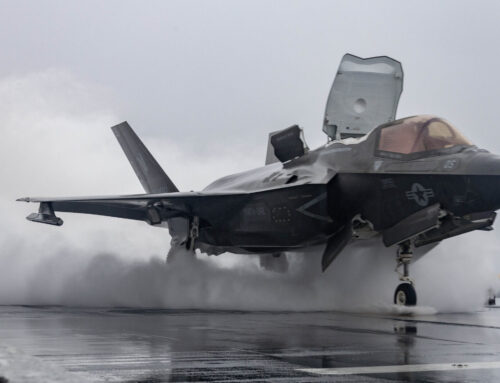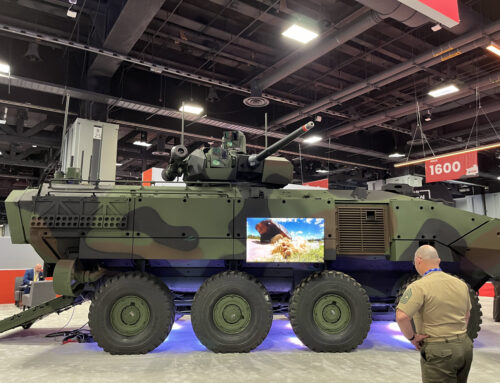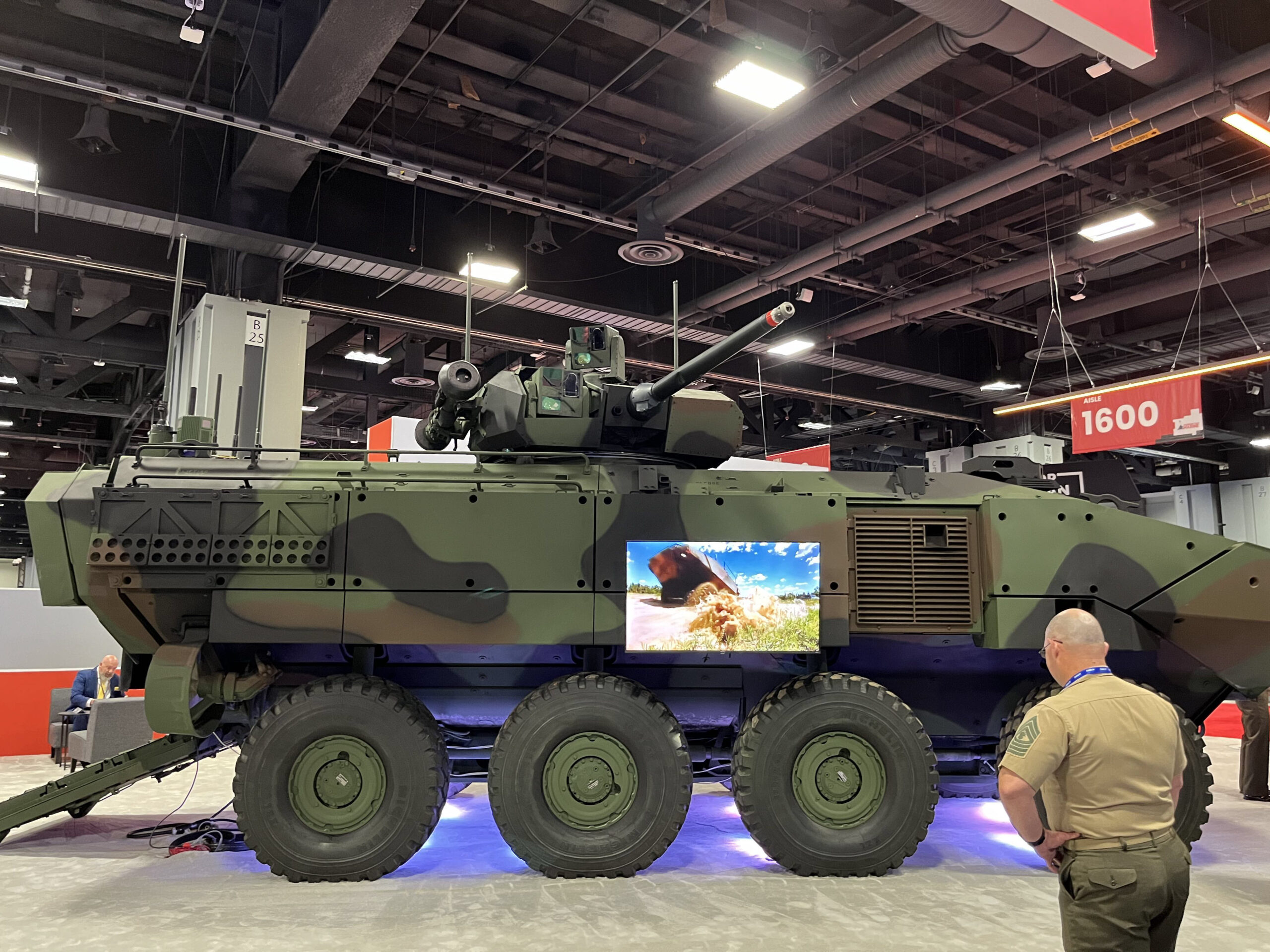This mystical creature is rolling his eyes because someone came up and said to him, “A werewolf? More like a war-wolf, amirite?” (Graphic Breaking Defense, original images via Getty/DVIDS; caption to be blamed on Editor-in-Chief Aaron Mehta)
WASHINGTON — With werewolves on the prowl and vampires stalking the shadows, there’s no more valuable munition on Halloween than silver bullets, legendarily capable of felling supernatural foes.
The concept of a silver bullet may have its origins in folklore, but the term long ago evolved to signify a simple, quick solution to an intractable problem.
And to listen to Pentagon officials and others in the US national security establishment beset with intractable problems — from Russia’s invasion of Ukraine to tech innovation to spooky drone incursions — the Defense Department could really use a few in their five-sided Trick or Treat baskets.
(The military does actually employ a “Silver Bullet,” an all-in-one secure comms capsule that can be loaded aboard transport aircraft to keep senior officials in communication, and apparently in comfort, while they’re in the air. But why let that get in the way of a good gag?)
This Halloween, Breaking Defense has collected a list of times defense leaders have openly wished that a silver bullet would appear, or lamented that one doesn’t seem available. This is a non-exhaustive list of all mostly from 2024, but still gives a sense of how the munitions shortage facing the US and its allies extends to the realm of the mystical.
The Serious Silver Bullet Ammo Shortage In Ukraine
Earlier this month, Defense Secretary Lloyd Austin made an impassioned speech (at least for him) in defense of America’s commitment to backing Kyiv.
But, he said, no one thing the US or any of its allies could give Ukraine would be the “silver bullet, no single capability will turn the tide.”
“What matters is the way that Ukraine fights back. What matters is the combined effects of your military capabilities. And what matters is staying focused on what works,” he said.
The speech could serve as a summary of US policy when it comes to capabilities provided to Ukraine, in which just about every major weapon system announced for Kyiv came with the same caveat: it’s not a silver bullet that will end the conflict.
That’s true of the decision to send American Abrams tanks, when then-Joint Chiefs Chairman Gen. Mark Milley said in April 2023, “I would also caution, there’s no silver bullet in war. … The outcomes of battles and wars are the function of many, many variables.” Or in August 2023 when Gen. James Hecker, commander of US Air Forces Europe, said the F-16’s future introduction to combat is “not going to be a silver bullet, [that] all of a sudden they’re going to start taking down [Russian air defenses] because they have an F-16.”
This year, officials used the phrase when discussing sending additional Patriot air defense batteries and the Ukrainian employment of the Army Tactical Missile System, better known as ATACMS.
“I believe they will make a difference. But as I’ve said before at this podium — and as you’ve heard from Secretary Austin, the Chairman, and other senior military officials — there is no silver bullet in this conflict,” White House National Security Advisor Jake Sullivan told reporters in April.
A few times this year officials have employed the silver bullet rhetoric to make the case against allowing Ukraine to strike more deeply into Russia with American arms than they are comfortable with — a long-running and ongoing controversy.
“You heard me say the other day that there is no silver bullet when it comes to things like this,” Austin said in September when asked about loosening restrictions on Kyiv. “One thing doesn’t determine the end of the end of a conflict or the transition in that conflict. It’s a combination of different things that create the effects that you want to create. But I think as you make those decisions, the goals and objectives need to be clear, what are you trying to accomplish as you employ those weapons systems?”
Missile And Drone Defense
Based partly on lessons they’ve learned from Ukraine, US officials have been increasingly concerned about the novel threat that drones present, combined with the older but still potent threat from missiles. And while none of those unmanned systems are haunted (we think), it sounds like a silver bullet would still be useful.
In April, Assistant Secretary of Defense for Space Policy John Plumb praised Integrated Air and Missile Defense (IAMD) systems, specifically saying that in both Ukraine and Israel, “air and missile defense systems have proven to be indispensable, life-saving assets: defending military forces, civilian populations, and critical infrastructure against unprovoked terror and aggression.”
But, as the reader may expect by now, he cautioned, “I don’t want to leave you with the impression that IAMD systems are a silver bullet against every type of sophisticated adversary threat.”
“Relying solely on traditional air and missile defense systems — with a limited number of interceptors, guided by large, detectable radars in closed fire control systems — can no longer be the only response against the array of technologically sophisticated offensive air and missile systems threatening U.S. interests,” he said.
Similarly, in December a senior US Army official said the service was purposefully not seeking a “silver bullet” solution to the growing drone problem, but a layered defense system.
PNT, CJADC2, DIB: Acronyms Also Silver Bullet-Proof
There’s certainly no shortage of specific tech problems that could use silver bullets.
One involves hardening US forces’ position, navigation and timing (PNT) so that they can operate in GPS-denied environments.
“There is no silver bullet,” Nikki Markiel, senior GEOINT authority for geomatics at the National Geospatial-Intelligence Agency (NGA), told Breaking Defense in May. “Everybody would like to have one. And I think that is where a lot of the struggle comes, because GPS has been easy. It’s ubiquitous.”
Another revolves around the Pentagon’s sprawling Combined Joint All-Domain Command and Control (CJADC2) initiative and the data-sharing its meant to do in an incredibly complex network environment.
“Our ability to push data in the places and to the people that need to get it right now is confined by whether or not you’re on a network that allows me to talk to you,” Brig Gen. Luke Cropsey, the Air Force’s integrating program executive officer for Command, Control, Communications and Battle Management (C3BM), said in July 2023.
To broaden JADC2 capabilities, Cropsey said he needs new tools to enable better data transfer, ones he cautioned would not materialize in a “silver bullet” solution.
More broadly, Deputy Defense Secretary Kathleen Hicks highlighted the silver bullet problem when looking back over her tenure in a 30,000-foot view of the defense industrial base’s ability to innovate within Pentagon acquisition structures.
“I think the biggest takeaway I could give you is that … any attempt to simplify to some kind of silver bullet system, fix to the system, you know, those will fail,” she said in March. “We have needs across the department that are vast and that kind of fall all across the spectrum, software, hardware, everything in between, and most importantly, integration of all of that.”
Just a few weeks before that, Hicks specifically discussed the institutional roadblocks when it comes to the development and adoption of artificial intelligence.
“So for three years, we’ve been taking a comprehensive, iterative, warfighter-centric approach to defense innovation writ large — recognizing we face an accumulation of challenges and barriers, and there is no silver bullet that will lower them all,” she said at the February Global AI Contest event.
More recently, she decried budgetary delays and its affect on the Pentagon’s plans.
“We’ve been able to deliver real outcomes,” Hicks said. “There is no silver bullet at a level that we’re talking about, [which is] the scale of the Defense Department.”
Perhaps Hicks, in her push for innovation, should have simply asked industry to come up with schematics for a truly devastating weapon: a silver bullet for all the DoD’s problems.










